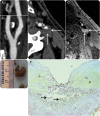Nonstenotic carotid plaque on CT angiography in patients with cryptogenic stroke
- PMID: 27412144
- PMCID: PMC4999163
- DOI: 10.1212/WNL.0000000000002978
Nonstenotic carotid plaque on CT angiography in patients with cryptogenic stroke
Abstract
Objective: To determine whether large (≥3 mm thick) but nonstenotic (<50%) carotid artery atherosclerotic plaque predominantly occurs ipsilateral rather than contralateral to cryptogenic stroke.
Methods: This was a cross-sectional observational study. Using a stroke registry, we identified consecutive patients with anterior circulation embolic stroke of undetermined source (ESUS). Using CT angiography, we measured carotid plaque size (thickness, mm) and carotid artery stenosis (North American Symptomatic Carotid Endarterectomy Trial method) for each patient. We dichotomized plaque size at several predefined thresholds and calculated the frequency of plaque size above each threshold ipsilateral vs contralateral to stroke.
Results: We included 85 patients with ESUS. Plaque with thickness ≥5 mm was present ipsilateral to stroke in 11% of patients, and contralateral in 1% (9/85 vs 1/85; p = 0.008). Plaque with thickness ≥4 mm was present ipsilateral to stroke in 19% of patients, and contralateral in 5% (16/85 vs 4/85; p = 0.002). Plaque with thickness ≥3 mm was present ipsilateral to stroke in 35% of patients, and contralateral in 15% (30/85 vs 13/85; p = 0.001). There was no difference in percentage stenosis ipsilateral vs contralateral to stroke (p = 0.98), and weak correlation between plaque size and stenosis (R(2) = 0.26, p < 0.001).
Conclusions: Large but nonstenotic carotid artery plaque is considerably more common ipsilateral than contralateral to cryptogenic stroke, suggesting that nonstenotic plaque is an underrecognized cause of stroke. We measured plaque size using CT angiography, a method that could be easily implemented in clinical practice.
© 2016 American Academy of Neurology.
Figures


Comment in
-
Nonstenotic carotid plaques: Stroke causation or guilt by association?Neurology. 2016 Aug 16;87(7):650-1. doi: 10.1212/WNL.0000000000002993. Epub 2016 Jul 13. Neurology. 2016. PMID: 27412136 No abstract available.
References
-
- Mohr JP, Thompson JL, Lazar RM, et al. . A comparison of warfarin and aspirin for the prevention of recurrent ischemic stroke. N Engl J Med 2001;345:1444–1451. - PubMed
-
- Bousser MG, Amarenco P, Chamorro A, et al. . Terutroban versus aspirin in patients with cerebral ischaemic events (PERFORM): a randomised, double-blind, parallel-group trial. Lancet 2011;377:2013–2022. - PubMed
-
- Hart RG, Diener HC, Coutts SB, et al. . Embolic strokes of undetermined source: the case for a new clinical construct. Lancet Neurol 2014;13:429–438. - PubMed
-
- Adams HP Jr, Bendixen BH, Kappelle LJ, et al. . Classification of subtype of acute ischemic stroke: definitions for use in a multicenter clinical trial: TOAST: Trial of Org 10172 in Acute Stroke Treatment. Stroke 1993;24:35–41. - PubMed
-
- Amarenco P, Bogousslavsky J, Caplan LR, Donnan GA, Wolf ME, Hennerici MG. The ASCOD phenotyping of ischemic stroke (Updated ASCO Phenotyping). Cerebrovasc Dis 2013;36:1–5. - PubMed
Publication types
MeSH terms
LinkOut - more resources
Full Text Sources
Other Literature Sources
Medical
